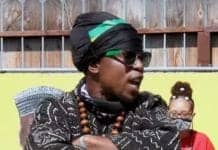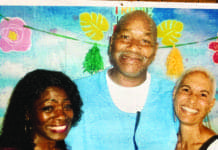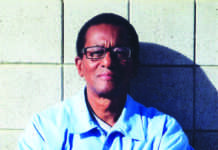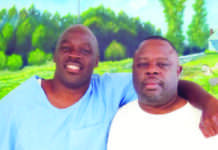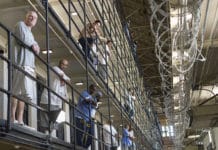
by Mutope Duguma
It’s always hard to stomach news that is disheartening. To hear that a brother and comrade has suffered a stroke after spending countless years in solitary confinement, as well as being held on an indefinite sentence for an alleged crime he did not commit, is even more disheartening.
I need not stress the sorrow that is felt amongst the whole prison population for our brother Sitawa Nantambu Jamaa, who, along with countless fearless prisoners, pioneered our Prison Human Rights Movement (PHRM) to the world’s stage. We continue to see men and women incarcerated far too long – beyond anyone’s imagination – and continue to be held indefinitely.
Our beloved brother Sitawa is amongst this class of men and women. The inhumane treatment of prisoners must end.
Our brother Sitawa and many others have suffered enough and should not continue to do so based on being given a life sentence that equals a civil death. Prior to 1968, under original Penal Code Section 2600, California prisoners suffered complete civil death, which means prisoners were stripped of all civil rights.
The prison system is actually covertly executing all of its lifers. The United States is the only country in the whole world that incarcerates people indefinitely – forcing them to spend the rest of their lives in prison. Men and women have been incarcerated for 35 years or more.
Many of these people are lost in time. They came to prison as youth in their teens and early 20s in the ‘60s, ‘70s and ‘80s. Yes, many of them were immature, many had no real direction, but they all became adults in the Amerikan prison system.
At present these prisoners, Baby Boomers, most of whom have survived decades of incarceration, are now between the ages of 60 and 80. Many of these senior citizens are wheelchair-bound or use assistive devices such as walking canes.
Like most seniors, many are on special medications, require special medical therapy for seniors, and suffer from aging illnesses of various sorts. I hear some say that a few manage to get around good at 70 years young.
Many say, yes, they should be in prison, and that may be true in some cases. Given the things they did in society, the way they carried themselves in the youth of their lives was utterly wrong and disrespectful, but that was decades ago when they were young! Decades!
They are now older, mature, grown, senior adults, who have fulfilled all requirements from various parole boards around the U.S. Multiple prisoners have complied with all laws, rules and regulations of the prison and carried themselves as role model human beings and in many cases have done so for decades.

Still, many of them are forced to remain in prison when the maximum amount of time on their sentence has long since expired. This is terrible and extremely cruel to force rehabilitated human beings to remain in bondage and especially when statistics clearly show that 90 percent of them are not returning to prison once released.
Sadly, 89 percent of prisoners across the US are Black and Mexican. From 1619 through the 1800s, the chattel slavery plantation concept lurks in the shadows like the Wizard of Oz.
This “behind the scenes” type strategy involves money laundering exclusively into white rural areas under the Prison Industrial Slave Complex (PISC). (That’s where prisons were built during the height of mass incarceration, in small rural communities that had lost their economic base, where people were so desperate for jobs, they were willing to work in a prison. These were white communities with deep prejudice toward Blacks. – ed.)
Many of us may very well die in these man-made tombs. It should be stipulated that these deaths are in clear violation of the Eighth Amendment of the US Constitution, which prohibits cruel and unusual punishment.
The suffering is indefinite where there exists no end to the punishment. Many have died, and many will continue to die where there is no remedy to resolve the cruel and unusual treatment of prisoners.
We must resist to end this cruel and unusual treatment of human beings and encourage our brother Sitawa, who is fighting for his life. We will fight for his freedom and the freedom of the thousands of men and women lost in time.
One Love, One Struggle,
Mutope Duguma
Send our brother some love and light: James Crawford (Mutope Duguma), D-05996, LAC B5-141, P.O. Box 4490, Lancaster CA 93539. Sitawa is recovering from a major stroke. Send him some love and light: Freedom Outreach, Attn: Sitawa Nantambu Jamaa, Fruitvale Station, P.O. Box 7359, Oakland CA 94601.
Editor’s note on Sitawa and Mutope: From the spring of 2011 until the winter of 2013, at least once a month the Bay View received stories to publish from Sitawa and Mutope, then in the dreaded Short Corridor of the Pelican Bay State Prison Security Housing Unit (SHU), where the historic mass hunger strikes were born … and grew and grew. The strikes were conceived and led by men who their jailers decided were the leaders of what were then considered the four main racial factions in the California prison system, Southern and Northern Latinos, Blacks and whites.
Sitawa represented all the Black prisoners in California, he and Mutope shared a tiny cell built for one person, and it was their writing in the Bay View, read by prisoners throughout the state, that informed everyone why they were striking – mainly against indefinite solitary confinement – and why their fellow prisoners should join them: They were subject to be thrown in the SHU too.
Because of those inspiring and persuasive stories and the Bay View’s ability to get them to tens of thousands of prisoners across the state, the California hunger strikes were the largest in world history: 6,600 prisoners participated in the first strike, 12,000 in the second and, by CDCr’s own count, 30,000 in the third. All of the strike leaders continue to be punished to this day, none has been granted parole yet and most remain in solitary confinement.

 Store
Store



